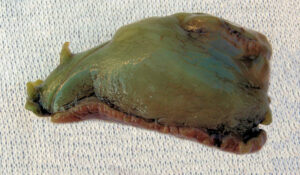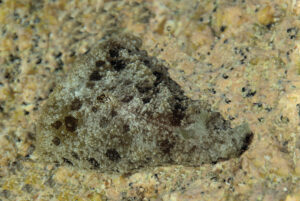Blunt End Sea Hare, Dolabella auricularia
 Blunt End Sea Hare, Dolabella auricularia. Sea Hare collected at Km 17, El Tule, Baja California Sur, photographed and returned to its native environment unharmed. Length: 18 cm (7.1 inches).
Blunt End Sea Hare, Dolabella auricularia. Sea Hare collected at Km 17, El Tule, Baja California Sur, photographed and returned to its native environment unharmed. Length: 18 cm (7.1 inches).
 Blunt End Sea Hare, Dolabella auricularia. Sea Hare provided by the commercial fishermen of the greater Los Cabos area, Baja California Sur, August 2009. Size: 7.5 cm (3.0 inches).
Blunt End Sea Hare, Dolabella auricularia. Sea Hare provided by the commercial fishermen of the greater Los Cabos area, Baja California Sur, August 2009. Size: 7.5 cm (3.0 inches).
 Blunt End Sea Hare, Dolabella auricularia. Sea Hare collected off the beach at Cabo Real, Km 21, Baja California Sur, photographed and returned to its native environment unharmed. Length: 18 cm (7.1 inches).
Blunt End Sea Hare, Dolabella auricularia. Sea Hare collected off the beach at Cabo Real, Km 21, Baja California Sur, photographed and returned to its native environment unharmed. Length: 18 cm (7.1 inches).
Phylogeny: The Blunt End Sea Hare, Dolabella auricularia (Lightfoot 1786), is a species of large sea slug and a member of the Aplysiidae Family of Sea Hares. They are also known as the Wedge Sea Hare and in Mexico, as Liebre de Mar Chata.
Morphology: The Blunt End Sea Hare vary in color. All are mottled shades of green and brown that afford them strong camouflage against their native backgrounds. They have triangular shaped bodies with highly truncated posterior end. There is a large exhalant siphon in the middle of the back and a smaller inhalant siphon in front of the shield. Buried within the body is a large flattened heavily calcified shell called a vestigal. When disturbed, they can release a reddish-purple ink. They reach a maximum length of 20 cm (7.9 inches) and are found in the first 15 m (50 feet) of the water column. They feed on a wide variety of brown and green algae, and have lifespans of approximately one year.
Habitat and Distribution: The Blunt End Sea Hare is found in sheltered bays or lagoons, in grass beds, and on sand or mud; they are also found in large intertidal rocky pools. The Blunt End Sea Hare is a global tropical water species and can be found in all Mexican Waters south of the 25th parallel latitude. Fossil records indicate that they date back to the Early Miocene Epoch.
Human Impact: Monomethyl Auristatin E (MMAE) is harvested from the Blunt End Sea Hare and when linked to a monoclonal antibody is used as an anti-cancer agent. They are also closely related California Sea Hare, Aplysia californica, has been widely studied by neurobiologists due to its abilities of learning and memory. This marine species is also often used in large saltwater aquariums to control the growth of algae. Lastly, the solid waste and eggs of the Blunt End Sea Hare are consumed as a delicacy in the Philippines, called lukot.
Synonyms: Patella auricularia, Aplysia ecaudata, Aplysia gigas, Aplysia hasseltii, Aplysia teremidi, Aplysia truncata, Dolabella andersoni, Dolabella callosa, Dolabella cheni, Dolabella ecaudata, Dolabella gigas, Dolabella hasseltii, Dolabella rumphii, Dolabella rumphii var. maculosa, Dolabella scapula, Dolabella variegata, Patella auricularia, Patella scapula.